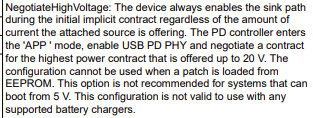Tool/software:
Hi Sir,
My customer want to use TPS25751 at their e-book product for liquid detect function.
1. If they want to start up TPS25751 from NegotiateHighVoltage, can they load code from EC after the Vin3V3 is ready and send GAID to TPS25751?
2. If they don't want to code reset PD in NegotiateHighVoltage startup, is there any method to set up PD? Write register directly or?
3. What's the main different between using 1 or 2 GPIO for liquid detect function?
Thanks and regards,
Gary Teng


